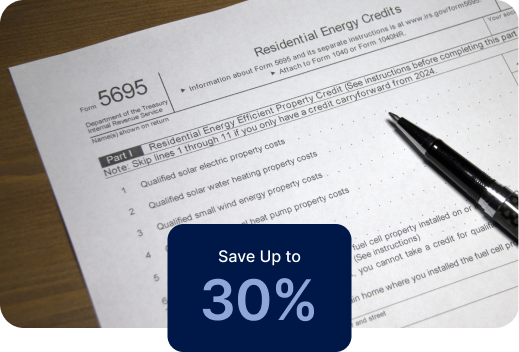The renewable energy sector continues to expand, despite policy uncertainty under the Trump administration.
Montana Solar Incentives: 2025 Overview
Montana offers valuable incentives to make solar energy more affordable. Homeowners can benefit from the 30% Residential Clean Energy Credit, and Montana’s net metering program allows residents to earn credits for excess energy, reducing future bills. With additional state tax exemptions and Montana’s sunny climate, going solar is a smart choice for cutting energy costs…

Residential Clean Energy Credit
The Clean Electricity Investment Credit (previously called the Federal Investment Tax Credit) helps lower the cost of installing solar panels by 30%. This credit covers everything: the solar panels, equipment, labor, permits, and even sales tax.
For example, as of 2025 the average cost of a 10 kW solar system in the U.S. typically ranges between $21,000 and $29,500 before applying any federal tax incentives. After claiming the 30% Clean Electricity Investment Credit, the price drops to around $14,980 to $21,070, depending on the state and other factors like equipment quality and labor costs.
To claim this credit, you must buy your solar system with cash or a loan (leases don’t qualify). You also need to owe enough in taxes to claim the credit, but if you don’t, you can carry it over to future years until 2034.

Claiming the Clean Electricity Investment Credit is simple!
Step 1
Print IRS Form 3468
Step 2
Fill out the form using info from your installer
Step 3
Submit it when you file your taxes
What are the top solar incentives in Montana?
Besides the Clean Electricity Investment Credit (former ITC), homeowners can take advantage of several outstanding incentives that significantly enhance the return on investment for solar panels. Here are some of the most effective ways to lower your solar installation costs.
Incentive
Savings
Summary
Residential Renewable Energy Tax Credit
A taxpayer may claim a credit of 30% of qualified expenditures, after deducting incentives, with no upper limit for a system that serves a dwelling unit located in the United States that is owned and used as a residence by the taxpayer. Expenditures with respect to the equipment are treated as made when the installation is completed. If the installation is at a new home, the “placed in service” date is the date of occupancy by the homeowner. Expenditures include labor costs for on-site preparation, assembly or original system installation, and for piping or wiring to interconnect a system to the home. If the federal tax credit exceeds tax liability, the excess amount may be carried forward to the succeeding taxable year. The excess credit may be carried forward until 2019, but it is unclear whether the unused tax credit can be carried forward after then.
Residential Photovoltaic (PV) Rebate Program
In 1997, Montana established the Universal System Benefits (USB) program. The USB legislation requires all electric and gas utilities to establish USB funds for low-income energy assistance, weatherization, energy efficiency activities, and development of renewable energy resources. A typical NorthWestern Energy residential customer pays approximately $1 per month in electric USB charges. About $9 million is collected annually by NorthWestern, and about $1.2 million is used for renewable energy projects. Most renewable energy projects include a public education or demonstration component to increase awareness of renewable energy. Residential solar PV incentives are available at a fixed rate of $2,000 per customer. The smallest residential system size supported is 2 kilowatts (kW).
Residential Renewable Energy Tax Credit
A taxpayer may claim a credit of 26% of qualified expenditures, after deducting incentives, with no upper limit for a system that serves a dwelling unit located in the United States that is owned and used as a residence by the taxpayer. Expenditures with respect to the equipment are treated as made when the installation is completed. If the installation is at a new home, the “placed in service” date is the date of occupancy by the homeowner. Expenditures include labor costs for on-site preparation, assembly or original system installation, and for piping or wiring to interconnect a system to the home. If the federal tax credit exceeds tax liability, the excess amount may be carried forward to the succeeding taxable year. The excess credit may be carried forward until 2020, but it is unclear whether the unused tax credit can be carried forward after then.
Residential Renewable Energy Tax Credit
A taxpayer may claim a credit of 22% of qualified expenditures, after deducting incentives, with no upper limit for a system that serves a dwelling unit located in the United States that is owned and used as a residence by the taxpayer. Expenditures with respect to the equipment are treated as made when the installation is completed. If the installation is at a new home, the “placed in service” date is the date of occupancy by the homeowner. Expenditures include labor costs for on-site preparation, assembly or original system installation, and for piping or wiring to interconnect a system to the home. If the federal tax credit exceeds tax liability, the excess amount may be carried forward to the succeeding taxable year. The excess credit may be carried forward until 2020, but it is unclear whether the unused tax credit can be carried forward after then.
Residential Renewable Energy Tax Credit
A taxpayer may claim a credit of 30% for the installation which was between 2022-2032 (Systems installed on or before December 31, 2019 were also eligible for a 30% tax credit), with no upper limit for a system that serves a dwelling unit located in the United States that is owned and used as a residence by the taxpayer. Expenditures with respect to the equipment are treated as made when the installation is completed. If the installation is at a new home, the placed in service date is the date of occupancy by the homeowner. Expenditures include labor costs for on-site preparation, assembly or original system installation, and for piping or wiring to interconnect a system to the home.
Alternative Energy System Credit
An income tax credit for individuals who install non-fossil fuel forms of energy including but not limited to wind, solar, and geothermal systems. The credit cannot exceed $500 per individual or $1,000 per married couple. Any remaining balance of the credit can be carried forward and applied to future income tax liabilities for a period of four succeeding tax years.
Disclaimer: The information provided here regarding solar incentives, tax credits, and rebates is for general informational purposes only and may vary based on your specific circumstances. For exact details, eligibility requirements, and current rates, we recommend consulting a certified solar installer or a tax professional. Incentives can differ by location, utility provider, and individual project, so it’s important to get personalized advice for your solar installation. Always verify the most up-to-date information from your local solar installer to understand how these incentives apply to your project.
Knowledge Base
Find everything you need to know about solar in your state and nationwide

Get a Quote
Discover the Ideal Solar System for Your Home in Just a Few Clicks!







